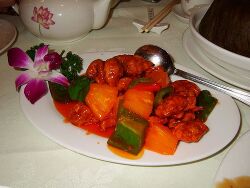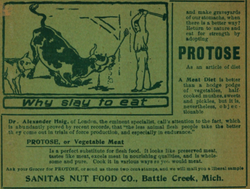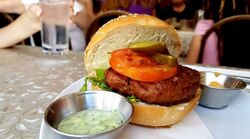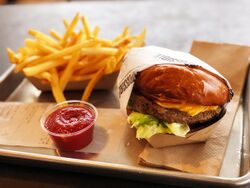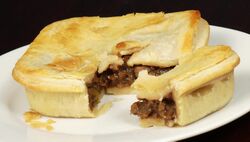Meat alternative
Topic: Engineering
 From HandWiki - Reading time: 19 min
From HandWiki - Reading time: 19 min
A meat alternative or meat substitute (also called plant-based meat, mock meat, or fake meat sometimes pejoratively), is a food product made from vegetarian or vegan ingredients, eaten as a replacement for meat. Meat alternatives typically approximate qualities of specific types of meat, such as mouthfeel, flavor, appearance, or chemical characteristics.[1][2][3] Plant- and fungus-based substitutes are frequently made with soy (e.g. tofu, tempeh, and textured vegetable protein), but may also be made from wheat gluten as in seitan, pea protein as in the Beyond Burger, or mycoprotein as in Quorn.[4]
Meat alternatives are typically consumed as a source of dietary protein by vegetarians, vegans, and people following religious and cultural dietary laws. However, global demand for sustainable diets has also increased their popularity among non-vegetarians and flexitarians seeking to reduce the environmental impact of meat production.
Meat substitution has a long history. Tofu was invented in China as early as 200 BCE,[5] and in the Middle Ages, chopped nuts and grapes were used as a substitute for mincemeat during Lent.[6] Since the 2010s, startup companies such as Impossible Foods and Beyond Meat have popularized pre-made plant-based substitutes for ground beef, patties, and vegan chicken nuggets as commercial products.
History
Tofu, a meat alternative[failed verification] made from soybeans, was invented in China by the Han dynasty (206 BC–220 CE). Drawings of tofu production have been discovered in a Han dynasty tomb.[5][7] Its use as a meat alternative is recorded in a document written by Tao Gu (simplified Chinese: 陶谷; traditional Chinese: 陶穀; pinyin: Táo Gǔ, 903–970). Tao describes how tofu was popularly known as "small mutton" (Chinese: 小宰羊; pinyin: xiǎo zǎiyáng), which shows that the Chinese valued tofu as an imitation meat.[failed verification] Tofu was widely consumed during the Tang dynasty (618–907), and likely spread to Japan during the later Tang or early Song dynasty.[5]
In the third century CE, Athenaeus describes a preparation of mock anchovy in his work Deipnosophistae:[8]
He took a female turnip, shred it fine
Into the figure of the delicate fish;
Then did he pour on oil and savoury salt
With careful hand in due proportion.
On that he strew'd twelve grains of poppy seed,
Food which the Scythians love; then boil'd it all.
And when the turnip touch'd the royal lips,
Thus spake the king to the admiring guests:
"A cook is quite as useful as a poet,
And quite as wise, and these anchovies show it."
Wheat gluten has been documented in China since the sixth century.[9] The oldest reference to wheat gluten appears in the Qimin Yaoshu, a Chinese agricultural encyclopedia written by Jia Sixie in 535. The encyclopedia mentions noodles prepared from wheat gluten called bo duo.[9] Wheat gluten was known as mian jin by the Song dynasty (960–1279).
Prior to the arrival of Buddhism, northern China was predominantly a meat-consuming culture. The vegetarian dietary laws of Buddhism led to development of meat substitutes as a replacement for the meat-based dishes that the Chinese were no longer able to consume as Buddhists. Meat alternatives such as tofu and wheat gluten are still associated with Buddhist cuisine in China and other parts of East Asia.[10] Meat alternatives were also popular in Medieval Europe during Lent, which prohibited the consumption of warm-blooded animals, eggs, and dairy products. Chopped almonds and grapes were used as a substitute for mincemeat. Diced bread was made into imitation cracklings and greaves.[6]
John Harvey Kellogg developed meat replacements variously from nuts, grains, and soy, starting around 1877, to feed patients in his vegetarian Battle Creek Sanitarium.[11] Kellogg's Sanitas Nut Food Company sold his meat substitute Protose, made from peanuts and wheat gluten. It became Kellogg's most popular product as several thousand tons had been consumed by 1930.[11]
There was an increased interest in meat substitutes during the late 19th century and first half of the 20th century.[12] Prior to 1950, interest in plant-based meat substitutes came from vegetarians searching for alternatives to meat protein for ethical reasons, and regular meat-eaters who were confronted with food shortages during World War I and World War II.[12]
Henrietta Latham Dwight authored a vegetarian cookbook, The Golden Age Cook-Book in 1898 which included meat substitute recipes such as a "mock chicken" recipe made from breadcrumbs, eggs, lemon juice and walnuts and a "mock clam soup" made from marrowfat beans and cream.[13] Dietitian Sarah Tyson Rorer authored the cookbook, Mrs. Rorer's Vegetable Cookery and Meat Substitutes in 1909.[13] The book includes a mock veal roast recipe made from lentils, breadcrumbs and peanuts.[13] In 1943, Kellogg made his first soy-based meat analog, called Soy Protose, which contained 32% soy.[11] In 1945, Mildred Lager commented that soybeans "are the best meat substitute from the vegetable kingdom, they will always be used to a great extent by the vegetarian in place of meat."[14]
In July 2016, Impossible Foods launched the Impossible Burger, a beef substitute which claims to offer appearance, taste and cooking properties similar to meat.[15] In April 2019, Burger King partnered with Impossible Foods to launch the plant-based Impossible Whopper, which was released nationwide later that year,[16] becoming one of the most successful product launches in Burger King's history.[17] By October 2019, restaurants, such as Carl's Jr, Hardee's, A&W, Dunkin Donuts, and KFC were selling plant-based meat products.[18] Nestlé entered the plant-based burger market in 2019 with the introduction of the "Awesome Burger".[19] Kellogg's Morningstar Farms brand tested its Incogmeato line of plant-based protein products in early September 2019, with plans for a US-wide rollout in early 2020.[20]
Types
Some vegetarian meat alternatives are based on centuries-old recipes for seitan (wheat gluten), rice, mushrooms, legumes, tempeh, yam flour or pressed-tofu, with flavoring added to make the finished product taste like chicken, beef, lamb, ham, sausage, seafood, etc. Other alternatives use modified defatted peanut flour, yuba and textured vegetable protein (TVP); yuba and TVP are both soy-based meat alternatives, the former made by layering the thin skin which forms on top of boiled soy milk,[21] and the latter being a dry bulk commodity derived from soy and soy protein concentrate. Some meat alternatives include mycoprotein, such as Quorn which usually uses egg white as a binder. Another type of single cell protein-based meat alternative (which does not use fungi however but rather bacteria[22]) is Calysta.
Production and composition
To produce meat alternatives with a meat-like texture, two approaches can be followed: bottom-up and top-down.[23] With bottom-up structuring, individual fibers are made separately and then assembled into larger products. An example of a meat alternative made using a bottom-up strategy is cultured meat. The top-down approach, on the other hand, induces a fibrous structure by deforming the material, resulting in fibrousness on a larger length scale. An example of a top-down technique is food extrusion.
The types of ingredients that can be used to create meat substitutes is expanding, from companies like Plentify, which are using high-protein bacteria found in the human microbiome,[24] to companies like Meati Foods, that are cultivating the mycelium of fungi—in this case, Neurospora crassa—to form steaks, chicken breasts, or fish.[25][26]
Soy protein isolates or soybean flour and gluten are usually used as foundation for most meat substitutes that are available on the market. Soy protein isolate is a highly pure form of soy protein with a minimum protein content of 90%. The process of extracting the protein from the soybeans starts with the dehulling, or decortication, of the seeds. The seeds are then treated with solvents such as hexane to extract the oil from them. The oil-free soybean meal is then suspended in water and treated with alkali to dissolve the protein while leaving behind the carbohydrates. The alkaline solution is then treated with acidic substances to precipitate the protein, before being washed and dried. The removal of fats and carbohydrates results in a product that has a relatively neutral flavor.[27] Soy protein is also considered a "complete protein" as it contains all of the essential amino acids that are crucial for proper human growth and development.[28]
After the textured base material is obtained, a number of flavorings can be used to give a meaty flavor to the product. The recipe for a basic vegan chicken flavor is known since 1972, exploiting the Maillard reaction to produce aromas from simple chemicals.[29] Later understanding of the source of aroma in cooked meat also found lipid oxidation and thiamine breakdown to be important processes. By using more complex starting materials such as yeast extract (considered a natural flavoring in the EU), hydrolyzed vegetable protein, various fermented foods, and spices, these reactions are also replicated during cooking to produce richer and more convincing meat flavors.[30][31]
Commerce
Meat substitutes represent around 11% of the world's meat and substitutes market (As of 2020). As shown in the graph, this market share is different from region to region.[32] From 2013 to 2021, the world average price of meat substitutes fell continuously, by an overall 33%. The only exception was a 0.3% increase in 2020, compared to 2019. The price will continue to decrease, according to projections by Statista (see average price graph).[33]
The motivation for seeking out meat substitutes varies among consumers. The market for meat alternatives is highly dependent on "meat-reducers", who are primarily motivated by health consciousness and weight management. Consumers who identify as vegan, vegetarian or pescetarian are more likely to endorse concerns regarding animal welfare and/or environmentalism as primary motivators.[35][36] Additionally, some cultural beliefs and religions place prohibitions on consuming some or all animal products, including Hinduism, Judaism, Islam, Christianity, Jainism, and Buddhism.
Vegan meats are consumed in restaurants, grocery stores, bakeries, vegan school meals, and in homes. The sector for plant-based meats grew by 37% in North America over 2017–18.[37] In 2018–19, sales of plant-based meats in the United States were $895 million,[38] with the global market for meat alternatives forecast to be $140 billion by 2029.[39] Seeking a healthy alternative to meat, curiosity, and trends toward veganism were drivers for the meat alternative market in 2019.[40] Sales of plant-based meats increased during the 2020 COVID-19 epidemic.[41] The book The End of Animal Farming by Jacy Reese Anthis argues that plant-based food and cultured meat will completely replace animal-based food by 2100.[42]
Impact
Environmental
Besides ethical and health motivations, developing better meat alternatives has the potential to reduce the environmental impact of meat production, an important concern given that the global demand for meat products is predicted to increase by 15 percent by 2031. Research on meats and no-meat substitutes suggests that no-meat products can offer substantial benefits over the production of beef, and to a lesser extent pork and chicken, in terms of greenhouse gas production, water and land use.[4] A 2022 report from the Boston Consulting Group found that investment in improving and scaling up the production of meat and dairy alternatives leads to big greenhouse gas reductions compared with other investments.[43]
According to The Good Food Institute, improving efficiency of the Western diet is crucial for achieving sustainability.[44] As the global population grows, the way land is used will be reconsidered. 33% of the habitable land on Earth is used to support animals. Of all the land used for agriculture, 77% is used on animal agriculture even though this sector only supplies 17% of the total food supply. Plant-based meat can use a potential 47–99% less land than conventional meat does, freeing up more opportunities for production. Of the total water used in global agriculture, 33% goes to animal agriculture while it could be used for drinking water or other growing purposes under a different strategy. Plant-based meat uses 72–99% less water than conventional meat production.[44]
Pollution is the next largest contribution to wasted water. Pesticides used in animal feed production as well as waste runoff into reservoirs can cause ecological damage and even human illness as well as taking water directly out of the usable supply. Animal agriculture is the main contributor to the food sector greenhouse gas emissions. Production of plant-based meat alternatives emits 30–90% less than conventional meat production. While also contributing less to this total pollution, much of the land being used for animal feed could be used to mitigate the negative effects we've already had on the planet through carbon recycling, soil conservation, and renewable energy production.[44] In addition to the ecological harm caused by the current industry, excess antibiotics given to animals cause resistant microbes that may render some of the life-saving drugs used in human medicine useless. Plant-based meat requires no antibiotics and would greatly reduce microbe antibiotic resistance.[44]
A 2023 study published in Nature Communications found that replacing just half of the beef, chicken, dairy and pork products consumed by the global population with plant-based alternatives could reduce the amount of land used by agriculture by almost a third, bring deforestation for agriculture nearly to a halt, help restore biodiversity through rewilding the land and reduce GHG emissions from agriculture by 31% in 2050, paving a clearer path to achieving both climate and biodiversity goals.[45][46][47]
Health
In 2021, the American Heart Association stated that there is "limited evidence on the short- and long-term health effects" of plant-based meat alternatives.[48] The same year, the World Health Organization stated that there are "significant knowledge gaps in the nutritional composition" of meat alternatives and more research is needed to investigate their health impacts.[49] An 2023 systematic review, however, concluded that replacing red and highly-processed meat with a variety of meat alternatives improved Quality Adjusted Life Years, led to significant health system savings, and reduced greenhouse gas emissions. Replacement of meat with minimally-processed vegetarian alternatives such as legumes had the greatest effect.[50]
Criticism
Companies producing plant-based meat alternatives, including Beyond Meat and Impossible Foods, have been criticized for their marketing and makeup of their products as well as their use of animal testing.[51] Dietitians have claimed they are not necessarily healthier than meat due to their highly processed nature and sodium content.[52][53]
John Mackey, co-founder and CEO of Whole Foods, and Brian Niccol, CEO of Chipotle Mexican Grill, have criticized meat alternatives as ultra-processed foods. Chipotle has claimed it will not carry these products at their restaurants due to their highly processed nature. CNBC wrote in 2019 of Chipotle joining "the likes of Taco Bell ... and Arby's in committing to excluding meatless meats on its menu."[54] In response, Beyond Meat invited Niccol to visit its manufacturing site to see the production process.[54] Chipotle later developed its own "plant-based chorizo".[55][56] In September 2022, Taco Bell also began adding plant-based meat alternatives to its menu.[57]
Some consulting firms and analysts demand more transparency in terms of the environmental impact of plant-based meat.[58] Through a survey, analysts from Deloitte discovered that some consumers negatively linked meat alternatives to being "woke" and politically-left leaning.[59] These ideas emerged in response to Cracker Barrel's introduction of Impossible Sausages in their restaurants in August, 2022.[60] In 2021, 68% of consumers who purchased plant based meats believed it was healthier than animal meat. The number dropping to 60% in 2022, demonstrating a decline in consumers beliefs in the healthiness of these meats.[59]
Some states have instituted legislation stating that meat alternatives are not allowed to label themselves as "meat". In Louisiana, the so-called, "Truth in Labeling of Food Products Act" was challenged by Tofurkey, complaining of free speech violations[61] and was successful on those grounds.[62]
Alternative meats companies Beyond Meat and Impossible Foods have attempted to appeal to meat eaters. University of Oregon marketing professor Steffen Jahn thinks that this has run afoul of human psychology, saying “the mimicking of real meat introduces that comparison of authenticity.”[63] Jahn argues that marketing plant-based meats with traditional meats leads to an artificiality that many consumers do not love. Consumer psychologists split foods into categories of “virtue” and “vice” foods, which ultimately guide how products are marketed and sold. Virtue foods are those that less gratifying appealing in the short term, and typically healthier, whereas vice foods are the opposite, having more long term consequences.[64] Many ready-made meat alternatives combine these categories with their long list of ingredients. Consumers who are likely to want to be “virtuous” by avoiding damage to the environment or animals are also likely to want “virtuous” food in the form of simple ingredients.[63]
See also
- Vegetarian bacon
- Vegetarian hot dogs
- Vegetarian sausage
- Meat-free sausage roll
- Soy curls
- Cultured meat
- Egg substitutes
- Insects as food
- List of bacon substitutes
- List of meat substitutes
- List of vegetarian and vegan companies
- Leghemoglobin: alters flavor of certain meat alternatives to make them taste even more similar to meat ("simulates" animal blood in these meat alternatives but made from plant-based sources)
- Milk substitute
- Single-cell protein, meat alternatives containing protein extract from pure or mixed cultures of algae, yeasts, fungi, or bacteria or made from air
- Timeline of cellular agriculture
References
- ↑ van der Weele, Cor; Feindt, Peter; Jan van der Goot, Atze; van Mierlo, Barbara; van Boekel, Martinus (2019). "Meat alternatives: an integrative comparison". Trends in Food Science and Technology 88: 505–512. doi:10.1016/j.tifs.2019.04.018.
- ↑ Nezlek, John B; Forestell, Catherine A (2022). "Meat substitutes: current status, potential benefits, and remaining challenges". Current Opinion In Food Science 47: 100890. doi:10.1016/j.cofs.2022.100890.
- ↑ Takefuji, Yoshiyasu (2021). "Sustainable protein alternatives". Trends in Food Science and Technology 107: 429–431. doi:10.1016/j.tifs.2020.11.012.
- ↑ 4.0 4.1 Holmes, Bob (20 July 2022). "How sustainable are fake meats?" (in en). Knowable Magazine. doi:10.1146/knowable-071922-1. https://knowablemagazine.org/article/food-environment/2022/how-sustainable-are-fake-meats. Retrieved 1 August 2022.
- ↑ 5.0 5.1 5.2 DuBois, Christine; Tan, Chee-Beng; Mintz, Sidney (2008). The World of Soy. National University of Singapore Press. pp. 101–102. ISBN 978-9971-69-413-5. https://books.google.com/books?id=tW6fjds6YwkC&pg=PA101.
- ↑ 6.0 6.1 Adamson, Melitta Weiss (2004). Food in Medieval Times. Greenwood Publishing Group. p. 72. ISBN 978-0-313-32147-4.
- ↑ William Shurtleff; Akiko Aoyagi (18 December 2014). History of Meat Alternatives (965 CE to 2014): Extensively Annotated Bibliography and Sourcebook. Soyinfo Center. ISBN 978-1-928914-71-6. https://www.soyinfocenter.com/pdf/179/MAL.pdf.
- ↑ Athenaeus. Deipnosophistae. Project Gutenberg. pp. 11. https://www.gutenberg.org/ebooks/36921.
- ↑ 9.0 9.1 Shurtleff, William; Aoyagi, Akiko; Huang, H.T. (2014). History of Soybeans and Soyfoods in China and Taiwan, and in Chinese Cookbooks, Restaurants, and Chinese Work with Soyfoods Outside China (1024 BCE to 2014). Soyinfo Center. pp. 2478–2479. ISBN 978-1-928914-68-6.
- ↑ Anderson, E.N. (2014). "China". Food in Time and Place. University of California Press. p. 44. ISBN 978-0-520-95934-7.
- ↑ 11.0 11.1 11.2 "Dr. John Harvey Kellogg and Battle Creek Foods". http://www.soyinfocenter.com/HSS/john_kellogg_and_battle_creek_foods.php.
- ↑ 12.0 12.1 Perren, Richard. (2017). Taste, Trade and Technology: The Development of the International Meat Industry Since 1840. Routledge. pp. 188–190. ISBN:978-0-7546-3648-9
- ↑ 13.0 13.1 13.2 Shprintzen, Adam D. (2013). The Vegetarian Crusade: The Rise of an American Reform Movement, 1817-1921. University of North Carolina Press. pp. 137–138. ISBN:978-1-4696-0891-4
- ↑ Lager, Mildred M. (1945). The Useful Soybean: A Plus Factor in Modern Living. McGraw-Hill Book Company. p. 95
- ↑ Reilly, Michael (22 June 2016). "Fake meat companies might finally cure our addiction to animal flesh". Technology Review. https://www.technologyreview.com/s/601756/if-the-world-gives-up-meat-we-can-still-have-burgers.
- ↑ Popper, Nathaniel (1 April 2019). "Behold the Beefless 'Impossible Whopper'". https://www.nytimes.com/2019/04/01/technology/burger-king-impossible-whopper.html.
- ↑ Chiorando, Marie (17 November 2019). "Impossible Whopper Is 'One Of Burger King's Most Successful Launches In History'". https://www.plantbasednews.org/lifestyle/impossible-whopper-burger-kings-most-successful-launches.
- ↑ Rivera, Dane (22 October 2019). "All The Major Fast Food Chains And Markets Selling Beyond Meat and Impossible Foods". Uproxx. https://uproxx.com/life/chains-serving-impossible-burger-beyond-meat/.
- ↑ Wiener-Bronner, Danielle (24 September 2019). "The Awesome Burger is Nestlé's answer to the plant-based meat craze". CNN Business (Cable News Network). https://www.cnn.com/2019/09/24/business/nestle-awesome-burger-plant-based-meat/index.html.
- ↑ Chung, Heidi (12 February 2020). "Food giant Kellogg's unveils 'Incogmeato' plant-based products". Yahoo! Finance. https://finance.yahoo.com/news/kelloggs-incogmeato-plantbased-meat-products-look-to-challenge-beyond-meat-201241228.html.
- ↑ Patterson, Daniel (6 August 2006). "The Way We Eat: I Can't Believe It's Tofu". The New York Times. https://www.nytimes.com/2006/08/06/magazine/06food.html.
- ↑ EOS, April 2019, page 52
- ↑ Dekkers, Brigit (November 2018). "Structuring processes for meat analogues". Trends in Food Science & Technology 81: 25–36. doi:10.1016/j.tifs.2018.08.011.
- ↑ Watson, Elaine (20 June 2020). "'Plentify' novel single cell protein 'ludicrously efficient' to produce vs animal protein, claims startup" (in en-GB). https://www.foodnavigator-usa.com/Article/2020/06/20/Plentify-novel-single-cell-protein-ludicrously-efficient-to-produce-vs-animal-protein-claims-startup.
- ↑ Peters, Adele (29 October 2019). "If it looks like a steak and tastes like a steak, in this case, it's a mushroom" (in en-US). Fast Company. https://www.fastcompany.com/90421889/if-it-looks-like-a-steak-and-tastes-like-a-steak-in-this-case-its-a-mushroom.
- ↑ "What is the most technical and scientific way to understand what Meati is made from and how we are branding it?". https://meati.com/mushroom-root?card=what-is-the-most.
- ↑ Sedgwick, Tali (28 June 2013). "Meat Analogs". Academy of Nutrition and Dietetics. http://www.foodandnutrition.org/July-August-2013/Meat-Analogs/.
- ↑ US patent US2682466A High protein food product and process for its preparation Robert A. Boyer, published 29 June 1954 US patent 5285709, "Meat Analog Compositions." Robert A. Boyer, issued 29 June 1954
- ↑ Perret, Marcel Andre (5 September 1972). "Chicken flavor and process for preparing the same". https://patents.google.com/patent/US3689289A/en.
- ↑ Kale, Prajyoti; Mishra, Anusha; Annapure, Uday S. (June 2022). "Development of vegan meat flavour: A review on sources and techniques". Future Foods 5: 100149. doi:10.1016/j.fufo.2022.100149.
- ↑ Li, Xuejie; Li, Jian (2020). "The Flavor of Plant-Based Meat Analogues". Cereal Foods World 65 (4). doi:10.1094/CFW-65-4-0040.
- ↑ 32.0 32.1 "Uprooting tradition: What plant-based alternatives mean for the future of protein". 21 May 2021. pp. 13–14. https://ca.rbcwealthmanagement.com/documents/634020/2734902/Uprooting+Tradition+What+Plant-based+alternatives+mean+for+the+future+of+protien.pdf/377e518f-0dc7-49d6-8c00-85a1a033441a. Formula: (Retail value meat substitutes) / (Retail value meat + retail value meat substitutes).
- ↑ 33.0 33.1 "Global: meat substitute price per unit 2013–2026" (in en). November 2021. https://www.statista.com/forecasts/1276529/worldwide-meat-substitute-price-per-unit. "all types of meat-like products that approximate certain aesthetic qualities (primarily texture, flavor, and appearance) or chemical characteristics of a specific meat. (...) includes plant-based meat and vegetarian meat [which] contains non-vegan ingredients"
- ↑ "Meat Substitutes – Worldwide | Statista Market Forecast" (in en). https://www.statista.com/outlook/cmo/food/meat/meat-substitutes/worldwide.
- ↑ "CONSUMER INSIGHTS". July 2018. https://media.ahdb.org.uk/media/Default/Consumer%20and%20Retail%20Insight%20Images/PDF%20articles/ConsumerInsights%20WEB_1653_180725.pdf.
- ↑ Penny, J. C.; Swift, J. A.; Salter, A. M. (2015). "'Meat reducers': meat reduction strategies and attitudes towards meat alternatives in an emerging group" (in en). Proceedings of the Nutrition Society 74 (OCE5). doi:10.1017/S0029665115003602. ISSN 0029-6651.
- ↑ Olayanju, Julia B. (30 July 2019). "Plant-based Meat Alternatives: Perspectives On Consumer Demands And Future Directions". Forbes. https://www.forbes.com/sites/juliabolayanju/2019/07/30/plant-based-meat-alternatives-perspectives-on-consumer-demands-and-future-directions/.
- ↑ Cheng, Andria (29 July 2019). "Beyond Meat Q2 Sales Quadruple, But Replacing Meat? That's A Different Story". Forbes. https://www.forbes.com/sites/andriacheng/2019/07/29/beyond-meat-q2-sales-quadruples-but-replacing-meat-thats-a-different-story/.
- ↑ Franck, Thomas (23 May 2019). "Alternative meat to become $140 billion industry in a decade, Barclays predicts". CNBC. https://www.cnbc.com/2019/05/23/alternative-meat-to-become-140-billion-industry-barclays-says.html.
- ↑ Mourdoukoutas, Panos (31 August 2019). "Veganism And Vegetarianism Are Changing Fast Food". Forbes. https://www.forbes.com/sites/panosmourdoukoutas/2019/08/31/veganism-and-vegetarianism-are-changing-fast-food/.
- ↑ "The big problem with plant-based meat: The 'meat' part" (in en-US). Washington Post. ISSN 0190-8286. https://www.washingtonpost.com/climate-solutions/2023/01/19/plant-based-meat-failing/.
- ↑ Reese, Jacy (6 November 2018). The End of Animal Farming: How Scientists, Entrepreneurs, and Activists are Building an Animal-Free Food System. Boston: Beacon Press. ISBN 9780807039878. https://www.penguinrandomhouse.com/books/567165/the-end-of-animal-farming-by-jacy-reese/.
- ↑ Carrington, Damian (2022-07-07). "Plant-based meat by far the best climate investment, report finds" (in en). https://www.theguardian.com/environment/2022/jul/07/plant-based-meat-by-far-the-best-climate-investment-report-finds.
- ↑ 44.0 44.1 44.2 44.3 The Good Food Institute. "Plant-based meat for a growing world". https://gfi.org/resource/environmental-impact-of-meat-vs-plant-based-meat/.
- ↑ Marashli, Imran (September 16, 2023). "Meat, milk alternatives could slash food system emissions a third: study". Phys.org. https://phys.org/news/2023-09-meat-alternatives-slash-food-emissions.html.
- ↑ Kozicka, Marta et al. (2023). "Feeding climate and biodiversity goals with novel plant-based meat and milk alternatives". Nature Communications 14 (5316). doi:10.1038/s41467-023-40899-2.
- ↑ Graham, Max (September 14, 2023). "New Study Shows Impacts of Cutting Meat and Dairy Consumption in Half". Mother Jones. https://www.motherjones.com/environment/2023/09/meat-dairy-consumption-farming-livestock-climate-emissions/.
- ↑ "2021 Dietary Guidance to Improve Cardiovascular Health: A Scientific Statement From the American Heart Association". Circulation 144 (23): e472–e487. December 2021. doi:10.1161/CIR.0000000000001031. PMID 34724806.
- ↑ "Plant-based diets and their impact on health, sustainability and the environment: A review of the evidence". WHO European Office for the Prevention and Control of Noncommunicable Diseases.
- ↑ Reynolds, Andrew N.; Mhurchu, Cliona Ni; Kok, Zi-Yi; Cleghorn, Christine (2023-02-01). "The neglected potential of red and processed meat replacement with alternative protein sources: simulation modelling and systematic review". eClinicalMedicine 56: 101774. doi:10.1016/j.eclinm.2022.101774. ISSN 2589-5370. PMID 36567793. PMC 9772543. https://www.sciencedirect.com/science/article/pii/S258953702200503X.
- ↑ "Why It's Impossible for PETA to Get Behind the Impossible Burger". https://www.peta.org/blog/why-it-is-impossible-for-peta-to-get-behind-the-impossible-burger/.
- ↑ Lucas, Amelia (4 July 2019). "Are Beyond Meat's plant-based burgers healthier than red meat? Dietitians say no." (in en). https://www.cnbc.com/2019/07/03/are-beyond-meats-burgers-healthier-than-red-meat-dietitians-say-no.html.
- ↑ Drayer, Lisa (2019). "They might be better for the planet, but are plant-based burgers good for you?". CNN Health. Retrieved 2 September 2020.
- ↑ 54.0 54.1 Lucas, Amelia (24 July 2019). "Beyond Meat CEO invites Chipotle for a tour after its fake meats are called too processed" (in en). https://www.cnbc.com/2019/07/24/beyond-meat-ceo-invites-chipotle-for-a-tour-after-its-fake-meats-are-called-too-processed.html.
- ↑ Lucas, Amelia (19 August 2021). "Chipotle is testing a meatless chorizo alternative in two markets". https://www.cnbc.com/2021/08/19/chipotle-is-testing-a-meatless-chorizo-alternative-in-two-markets.html.
- ↑ Lucas, Amelia (3 January 2022). "Chipotle adds meatless chorizo to its menu for limited time". https://www.cnbc.com/2022/01/03/chipotle-adds-meatless-chorizo-to-its-menu-for-limited-time.html.
- ↑ Martin, Brittany (2022-09-21). "Taco Bell Is Putting Beyond Meat on the Menu – And We Tasted It" (in en). https://www.vegetariantimes.com/news/taco-bell-beyond-meat-steak/.
- ↑ Creswell, Julie (15 October 2021). "Plant-Based Food Companies Face Critics: Environmental Advocates" (in en-US). The New York Times. ISSN 0362-4331. https://www.nytimes.com/2021/10/15/business/beyond-meat-impossible-emissions.html.
- ↑ 59.0 59.1 "Plant based meat sales slowing" (in en-us). https://www2.deloitte.com/us/en/insights/industry/retail-distribution/future-of-fresh-food-sales/plant-based-meat-sales.html.
- ↑ Valinsky, Jordan (2022-08-04). "Cracker Barrel sparks uproar for plant-based sausage critics say is 'woke' | CNN Business" (in en). https://www.cnn.com/2022/08/04/business-food/cracker-barrel-impossible-meat-controversy/index.html.
- ↑ "Pickin' on Veggies: Louisiana's "Truth in Labeling of Food Products Act"". January 22, 2020. https://lawreview.law.lsu.edu/2020/01/22/pickin-on-veggies-louisianas-truth-in-labeling-of-food-products-act/#:~:text=Louisiana's%20Truth%20in%20Labeling%20of%20Food%20Products%20Act%20is%20supposedly,a%20likely%20target%20for%20litigation.
- ↑ "Veggie 'Meat' Maker Tofurky Wins Free Speech Challenge to Food-Labeling Law". March 31, 2022. https://reason.com/2022/03/31/veggie-meat-maker-tofurky-wins-free-speech-challenge-to-food-labeling-law/?utm_medium=email.
- ↑ 63.0 63.1 Osaka, Shannon (2023-01-23). "The big problem with plant-based meat: The ‘meat’ part" (in en-US). Washington Post. ISSN 0190-8286. https://www.washingtonpost.com/climate-solutions/2023/01/19/plant-based-meat-failing/.
- ↑ van Doorn, Jenny; Verhoef, Peter C. (September 2011). "Willingness to pay for organic products: Differences between virtue and vice foods". International Journal of Research in Marketing 28 (3): 167–180. doi:10.1016/j.ijresmar.2011.02.005. ISSN 0167-8116. http://dx.doi.org/10.1016/j.ijresmar.2011.02.005.
Further reading
- Yes, plant-based meat is better for the planet. Vox. 18 November 2021.
- Plant-based meat is a simple solution to climate woes – if more people would eat it. Associated Press. 1 December 2023.
 |
 KSF
KSF
